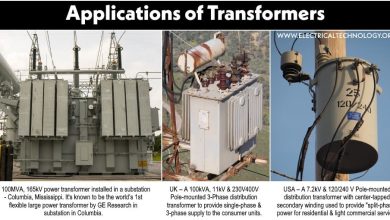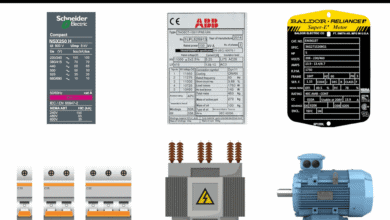Why is the Synchronous Motor Not Self Starting?
Why are Synchronous Motor and Synchronous Machines Not Self Starting?
We know that a synchronous motor is not a self starting machine. This is because when the armature (stator) of the synchronous motor is connected to the three phase supply, a rotating magnetic field is produced in it which rotates at synchronous speed while the rotor is in static position.
When the static field poles of the rotor are excited through an external DC source, the rotor poles attract to the first and then second direction. This way, the resultant torque at the rotor field is almost zero “0” hence the synchronous motor won’t start automatically.
This is why an external source is needed to reach the synchronous speed and make the synchronous motor a self-starting machine. The Synchronous speed of a synchronous motor is given by
NS = 120f / p
Where
- NS = Synchronous speed (RPM)
- f = Frequency of supply current
- p = No. of poles
Related Posts:
- Synchronous Motor: Construction, Working, Types & Applications
- Alternator or Synchronous Generator: Construction, Working, Types & Applications
Let’s consider a simple 3-phase synchronous motor having two stator poles (NS, SS) and two rotor poles (Nr, Sr) as shown in the figure below.
A 3-phase AC is supplied to the stator winding and steady DC is supplied to the rotor winding. The DC supply magnetizes the rotor forming a stationary magnetic field having Nr, and Sr poles while the AC supply generate RMF that revolves.
Initially, the rotor is stationary and the stator RMF revolves at synchronous speed in the clockwise direction. The rotor and stator poles can be in two positions. If the same poles are near each other as shown in the figure. The poles will repel each other generating an anticlockwise torque in the rotor. If the opposite poles are near each other, they will attract each other generating a clockwise torque in the rotor.
The stator RMF revolves at a very fast speed as compared to the rotor. The rotor cannot attain the synchronous speed at one due to its inertia. Therefore, the poles of the rotor and stator interchange. In the case of the same poles at the start, opposite poles come near each other and attract the rotor generating clockwise torque. While in the case of opposite poles, the same poles come near each other repelling the poles and generating anticlockwise wise torque.
As we see, in both cases, the torque in the rotor reverses in a single RMF cycle. It experiences attraction and repulsion at the same time. It means that the motor won’t start unless the rotor is brought up to the speed of the RMF (synchronous speed) using any means. Therefore, synchronous motors are not inherently self-starting motors.
There are multiple ways used to start a synchronous motors via external sources as follows:
- By reducing the electrical frequency
- By using a DC source
- Motor starting with an external prime mover
- Starting by means of auxiliary drive or pony motor
- Self starting by means of damper winding
The methods of providing the low voltage to the stator of the synchronous motor are the same which are used to start an induction motor using as starter e.g.
- Direct online starting method
- Reactor starting method
- Autotransformer starting method
- Line resistance method
- Star-Delta starting method
Keep in mind that there are multiple types of self starting synchronous motors (discussed in our previous post under the title of un-excited synchronous motors) such as:
- Hysterias motors
- Reluctance motors
- Permanent magnet synchronous motors
Related Posts:
- Different Types of Electrical motors
- Difference Between AC and DC Motors
- Difference between Synchronous and Asynchronous Motor
- Difference Between AC and DC Generator
- Difference Between Alternator and Generator with Comparison
- Why is a Motor Rated in kW instead of kVA?
- What is Motor Efficiency and How to improve it?
- Why Do We Need to Install a Starter with a Motor?
- How to Run a Three-Phase Induction Motor on a Single-Phase Power Supply?








